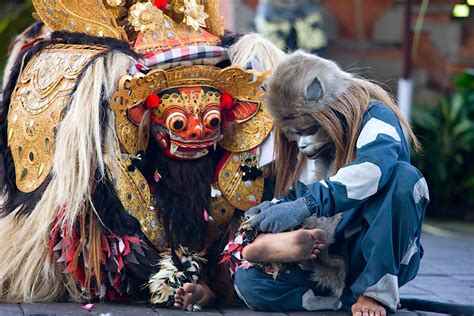balinese dances
Balinese dance is an integral part of Bali's rich cultural heritage, embodying the island's spiritual and artistic traditions. These dances are not merely performances but are deeply rooted in religious rituals and community life, often depicting stories from Hindu epics and local folklore. Characterized by intricate movements, expressive gestures, and elaborate costumes, Balinese dances serve as a medium to convey devotion, celebrate nature, and narrate historical tales.
Here are five of the most important and renowned traditional dances in Bali:

Barong Dance
The Barong Dance portrays the eternal struggle between good and evil. Barong, a lion-like creature symbolizing good, battles Rangda, the demon queen representing evil.
This dance is a vivid representation of the Balinese belief in the balance of opposing forces. Accompanied by gamelan music, performers in elaborate costumes enact this mythological tale, captivating audiences with dynamic movements and dramatic expressions.
The Barong Dance is not only a form of entertainment but also a spiritual performance, believed to bring protection and blessings to the community.

Legong Dance
Legong is a classical Balinese dance known for its intricate finger movements, complex footwork, and expressive facial gestures.
Traditionally performed by young girls, the dance narrates tales from ancient Hindu epics and Balinese folklore. Dancers wear ornate costumes and gold headdresses, moving in perfect unison to the rhythms of the gamelan orchestra.
The refined elegance of the Legong Dance showcases the grace and discipline inherent in Balinese performing arts.

Kecak Dance
Also known as the "Monkey Chant," the Kecak Dance is a mesmerizing performance featuring a chorus of male dancers chanting "cak" in rhythmic harmony.
Originating from a traditional trance ritual, this dance reenacts scenes from the Ramayana, particularly the story of Prince Rama's quest to rescue his wife, Sita, from the demon king Ravana.
Performed at sunset, often against dramatic backdrops like Uluwatu Temple, the Kecak Dance offers a hypnotic and unforgettable cultural experience.

Pendet Dance
The Pendet dance is one of Bali’s most iconic traditional dances, originally performed as a religious offering in temples.
Unlike many Balinese dances that are reserved for trained dancers, Pendet was traditionally performed by women of all ages, reflecting a communal spirit of devotion.
The dance involves graceful, flowing movements and the scattering of flower petals to welcome deities descending to earth.
Over time, Pendet evolved into a welcoming dance for guests, especially during cultural performances or ceremonies. It is often performed by a group of young women in colorful traditional attire, with golden headdresses and fans or flower bowls in hand. The dance blends elegance with spiritual meaning, capturing the essence of Balinese hospitality and devotion.

Topeng Dance
Topeng, meaning "mask" in Indonesian, is a form of dance drama where performers wear intricately crafted masks to portray various characters from Balinese history and mythology.
Accompanied by gamelan music, the dancers enact stories that blend humor, tragedy, and moral lessons.
The Topeng Dance serves both as entertainment and as a medium for preserving and transmitting cultural narratives, highlighting the rich storytelling traditions of Bali.







